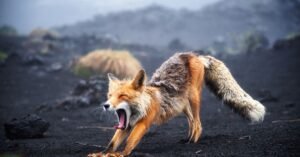Meet the Red Fox: Nature’s Cunning and Adorable Creature
Introduction:
In the vast and varied world of wildlife, there’s a creature that often captures our imagination with its fiery fur and intelligent eyes – the red fox. With its reputation for cunning and agility, the red fox is not just a symbol of wilderness but also a fascinating subject for exploration. Let’s delve into the world of this charismatic mammal and uncover its secrets.
1. A Closer Look at the Red Fox:
The red fox, scientifically known as Vulpes vulpes, is a member of the Canidae family, which includes wolves, coyotes, and domestic dogs. Despite its name, not all red foxes have red fur; their fur can vary from reddish-brown to gray, depending on their habitat and region. One distinctive feature of the red fox is its bushy tail, which it uses for balance and warmth during cold winters.

2. Habitat and Distribution:
Red foxes are highly adaptable creatures, found in a wide range of habitats across the Northern Hemisphere, including forests, grasslands, deserts, and urban areas. They are particularly common in Europe, Asia, and North America. Red foxes are known for their ability to thrive in diverse environments, making them one of the most widespread carnivores in the world.
3. Lifestyle and Behaviour:
Red foxes are primarily nocturnal animals, meaning they are most active during the night. However, they are also known to be crepuscular, meaning they are active during dawn and dusk. These adaptable creatures are opportunistic hunters and scavengers, feeding on small mammals, birds, insects, fruits, and even garbage in urban areas.

4. Social Structure:
While red foxes are solitary hunters, they do form social groups during certain times of the year, particularly during the breeding season. A typical red fox family consists of a mated pair and their offspring. The parents work together to raise and protect their young until they are old enough to fend for themselves.
5. Communication:
Communication is key for red foxes, who use a variety of vocalisations, body language, and scent marking to convey messages to one another. Their repertoire of sounds includes barks, whines, growls, and screams, each serving different purposes such as warning of danger or signaling mating readiness.

6. Reproduction and Life Cycle:
Red foxes typically mate in the winter, with the female giving birth to a litter of pups in the spring. The size of the litter can vary but usually ranges from four to six pups. The parents play an active role in caring for their young, teaching them essential survival skills until they are ready to venture out on their own at around six to eight months of age.
7. Conservation Status:
While red foxes are not currently considered endangered, they do face threats from habitat loss, hunting, and disease. Conservation efforts focus on protecting their habitats and managing human-wildlife conflicts in urban areas. Educating communities about the importance of coexisting with wildlife is also crucial for their long-term survival.

Conclusion:
The red fox is a symbol of resilience and adaptability in the natural world. From its fiery fur to its cunning behavior, this captivating creature continues to inspire awe and admiration in people of all ages. By learning more about the red fox and the role it plays in ecosystems, we can better appreciate the wonders of the animal kingdom and strive to protect them for future generations to enjoy.

